International Phonetic Alphabet to learn French Pronunciation
Updated: 9 June, 2023 by Mylene in Pronunciation Lessons ▪

Learn how to pronounce sounds in French with the International Phonetic Alphabet for French, or IPA. This article includes detailed descriptions, audio recordings, and a video to teach learners the right way to pronounce French sounds.
French Phonetics
There are 26 scripted letters in the modern French alphabet. But there are at least 35 phonetic sounds in modern French speech.
You’ll find all the phonetic sounds so that you can listen to these sounds and learn how to pronounce them in French: the oral vowels, the nasal vowels, the semi-consonants, the oral consonants, the nasal consonants.
For more information about French phonetics, I published an article that discusses the many facets of learning French pronunciation.
French IPA
In this post you’ll learn:
- International phonetic alphabet (a video)
- The French vowel system
- How to pronounce vowels in French?
- How to pronounce the nasal vowels In French?
- How to pronounce the semi consonants in French?
- How to pronounce the oral consonants in French?
- How to pronounce the nasal consonants in French?
Practice French pronunciation
Do you speak English? If you’re reading this article, then there is a big chance that the answer is yes. But still, you may be wondering why a French language coach is asking “do you speak English”, right?
Alright, You Do Speak English
English speakers, the good news is that you already know how to pronounce 60% of the French sounds. What you still have to learn is to pronounce 3 more consonants and 10 vowels! And you’ll be able to pronounce most of the French sounds. Of course, there are specific pronunciation difficulties that depend on the mother tongue of the learner. Here is a list of the main pronunciation difficulties for English speakers when learning French.
International Phonetic Alphabet (IPA video)
Check the video below, where I show you how to use the International Phonetic Alphabet (IPA) to learn all the French sounds and practice the French pronunciation.
Watch this video to learn how to pronounce all the sounds in French. To follow more updates, subscribe to the YouTube channel and follow me on Instagram.
The French vowel system
What determines the sound of a vowel is the position of:
- the tongue
- the mouth
- the lips
To help in this process, you will first develop physical awareness of your tongue’s location in your mouth and your lips. Let’s go on and take a look at the vowel system of French.
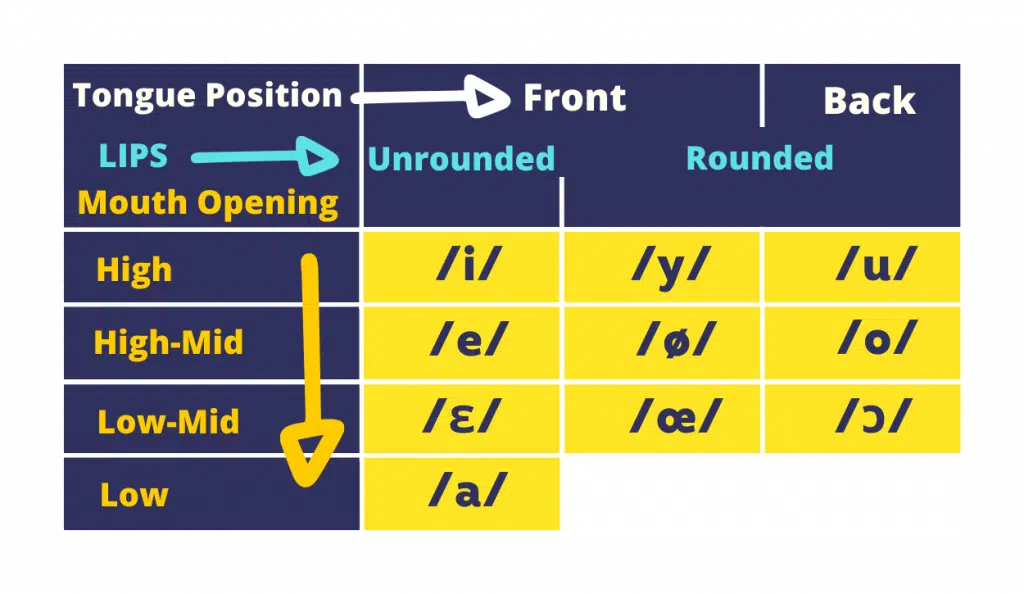
Vowels in French
From the chart above, you’ll notice that they’re symbols used to represent those vowels and they come from the International Phonetic Alphabet.
What are the oral vowels in French?
There are 14 vowels in French and 11 of them are oral. This means that all of the air goes through your mouth. Here is the list of the eleven oral vowels in French:
- /i/ like in samedi
- /e/ like in manger
- /ɛ/ like in fête
- /a/ like in ami
- /o/ like in eau
- /ɔ/ like in bonne
- /u/ like in aujourd’hui
- /y/ like in muguet
- /ø/ like in monsieur
- /œ/ like in jeune
- /ə/ like in de
To learn the pronunciation of many of these words, check our articles on how to pronounce French words — you’ll find the pronunciation of words like aujourd’hui, monsieur, and eau.
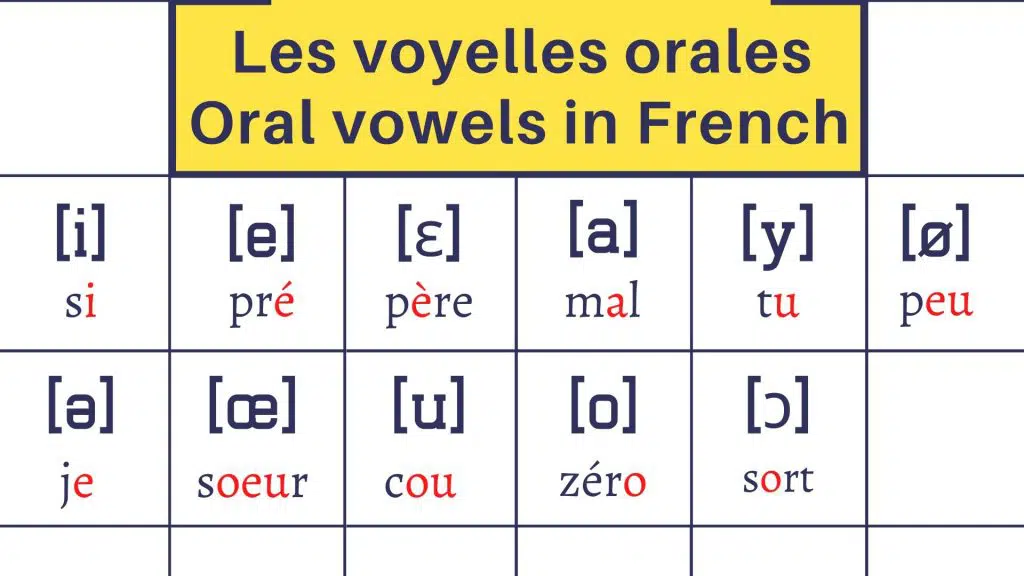
What are the nasal vowels in French?
Out of the 14 vowels in French, three of them are nasal vowels that mean that some of the air comes out of your nose. Here are the three nasal vowels in French:
- /ɛ̃/ as in the word ainsi
- /ɔ̃/ as in the word pont
- /ɑ̃/ like the word en as in en un instant
To master the French pronunciation, you can read a related article about French Nasal Vowels in Liaisons.
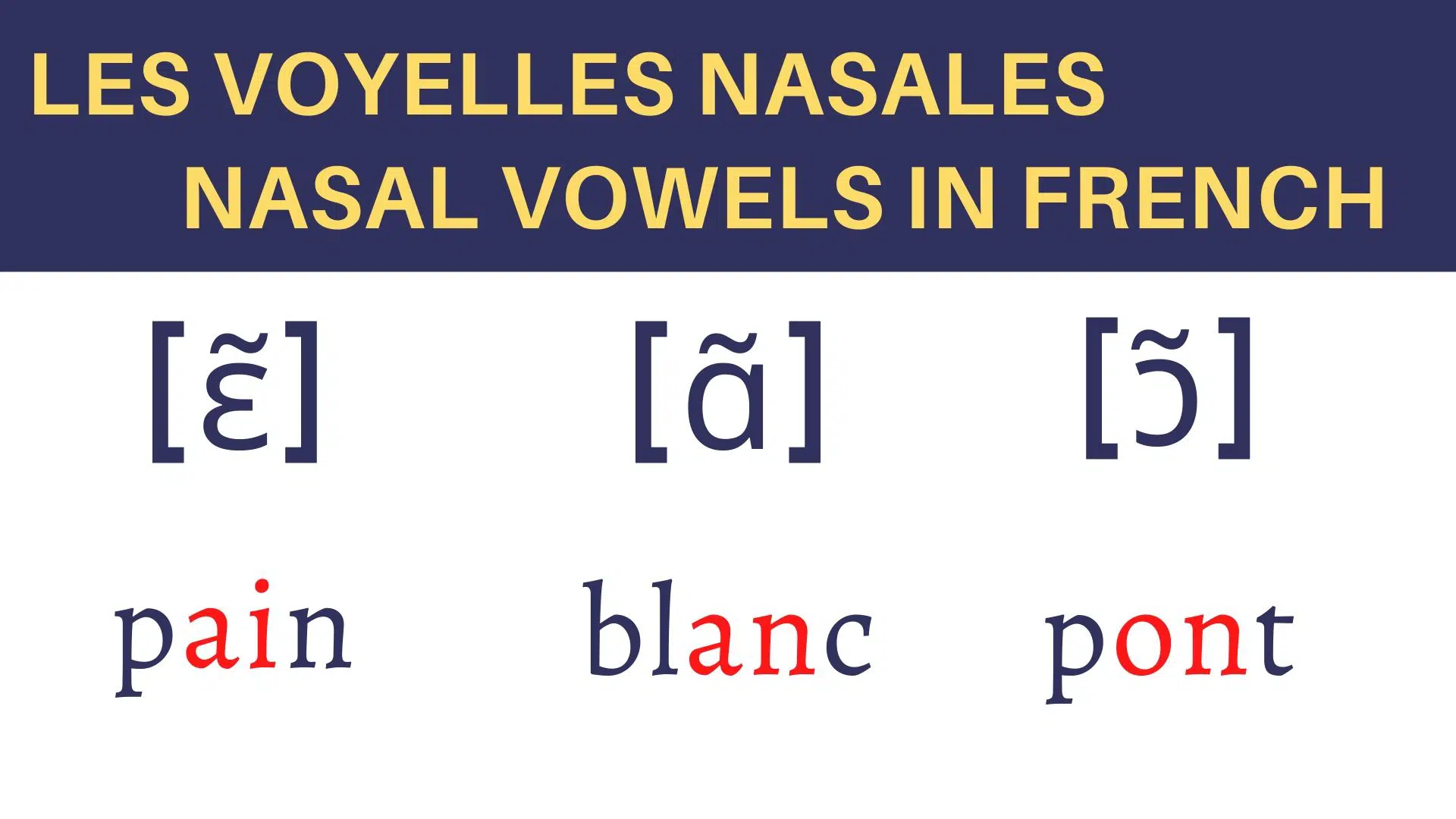
How to pronounce Vowels in French?
French vowels /i/ /e/ /ɛ/ /a/
Spread your lips to pronounce these French vowels
I’ll start with the vowel where your mouth is less open, your teeth are touching and gradually I’ll open the mouth. Here are the French vowels in the mentioned order:
- /i/: Your tongue should touch the front lower teeth. Your lips should be tensed, and the corners of your mouth slightly stretched apart. Your lips should only be slightly open. Your vocal cords vibrate.
- /e/: The tongue is forward in the mouth, the tip of the tongue is against the lower teeth and the lips are unrounded. Your vocal cords vibrate.
- /ɛ/: We call it an open /e/ because the mouth is literally a little bit more open when you say it. The tongue touches the front lower teeth. The mouth is much more open. The muscles of your mouth should be relaxed. Your vocal cords vibrate.
- /a/: Your mouth is much more open and the tip of the tongue is forward. Your vocal cords vibrate.
Listen to the sound of French vowels. Click to listen to the French sound of /i/ /e/ /ɛ/ /a/.
French vowels /u/ /o/ /ɔ/
Make the lips rounded and the tongue back
Let’s now listen to three vowels that are said with the lips rounded. I’ll start with the one said with your mouth less open and then I’ll gradually open the mouth.
- /u/: The tongue is back, the mouth is slightly open and the lips are rounded. Your vocal cords vibrate.
- /o/: The tongue is back, the mouth is more open and the lips are rounded. Your vocal cords vibrate.
- /ɔ/: We call it an open /o/ because the mouth is literally a little bit more open when you say it. To make this sound the tongue is raised a little bit toward the back of the mouth and the lips are rounded. Your vocal cords vibrate.
Listen to the sound of French vowels. Click to listen to the French sound of /u/ /o/ /ɔ/.
French vowels /y/ /ø/ /œ/
Make the lips rounded and the tongue forward
Let’s now listen to three vowels that are said with the lips rounded and the tongue forward.
- /y/: The tongue is forward, the mouth is slightly open. The lips are rounded. Your vocal cords vibrate.
- /ø/: The tongue is forward in the mouth, the tip of the tongue is against the front lower teeth and the lips are rounded. Your vocal cords vibrate.
- /œ/: We call it an open /ø/ because the mouth is literally a little bit more open when you say it. Your vocal cords vibrate. The mouth is much more open, the tongue touches the front lower teeth.
/ə/: The tongue is in the central part of the mouth, the mouth is more relaxed and the lips are slightly rounded.
Listen to the sound of French vowels. Click to listen to the French sound of /y/ /ø/ /œ/ /ə/.
How to pronounce the nasal vowels in French?
In most varieties of French, there are three nasal vowels. In nasal vowels, the air comes out of the nose and out the mouth as you speak. Here are the details:
- /ɛ̃/: The mouth is slightly open and stretched horizontally, the tip of the tongue touches the front lower teeth. Your vocal cords vibrate.
- /ɔ̃/: The mouth is closed and the lips are tightly rounded. The tongue is back. This is the nasal version of the oral vowel /o/ but the uvula and soft palate move down to allow air to pass through the nose as well as through the oral cavity.
- /ɑ̃/: The mouth is wide open and relaxed. The tongue is back. Your vocal cords vibrate.
Listen to the sound of French nasal vowels. Click to listen to the French sound of /ɛ̃/ /ɔ̃/ /ɑ̃/
How to pronounce the semi consonants in French?
The semi consonants, also called semi-vowels, in French are:
- /j/ as in the word grenouille
- /w/ as in the word droite
- /ɥ/ as in the word pluie
They have the vocalic qualities of a vowel but don’t form a separate syllable. For example, the /ɥ/ sound needs another vowel to make a sound. It is usually followed by /i/ as in: huit, je suis, aujourd’hui, la nuit, juillet, la cuisine.
The pronunciation of the semi consonants in French is as follows:
- /j/: The tongue is slightly more forward. It is the same sound as the beginning of the English word “yes”. Your vocal cords vibrate.
- /w/: To make it, start by rounding your lips into an “o” shape. Vibrate your vocal cords, and widen your lips, spreading them into the shape of whatever vowel follows the /w/ in the word.
- /ɥ/: To make it, try to pronounce the /y/ sound first and then move very rapidly to pronounce the following vowel. Your vocal cords vibrate.
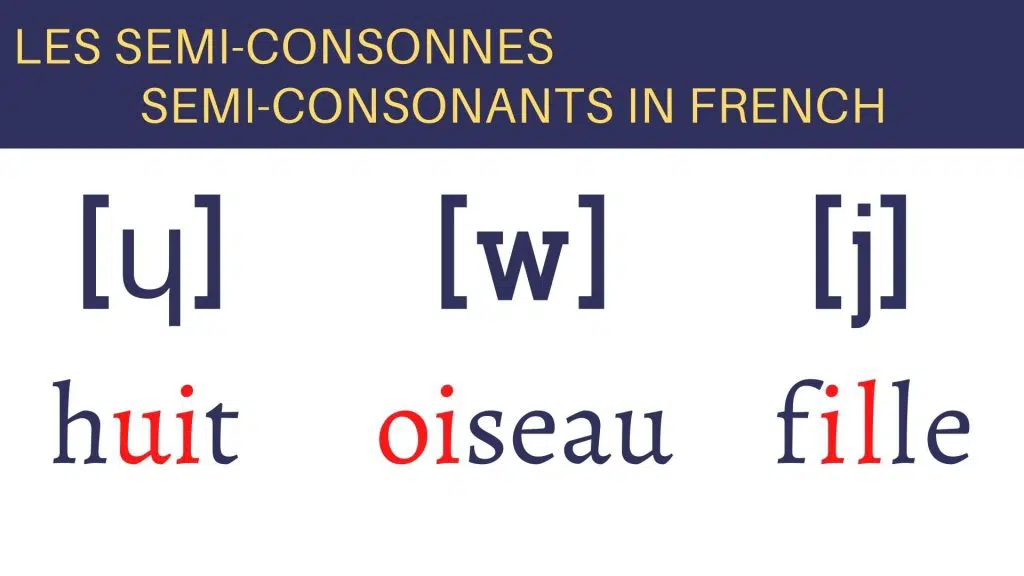
Listen to the sound of semi consonants in French. Click to listen to the French sound of /j/ /w/ /ɥ/.
You can also check this article about French consonants.
How to pronounce the oral consonants in French?
The oral consonants in French are: /p/ /b/ /t/ /d/ /f/ /v/ /k/ /g/ /s/ /z/ /ʃ/ /ʒ/ /ʁ/ /l/.
- /p/: Close the lips and push air through the mouth against the closure. Do not close your teeth. Hold it back very briefly, and then release it with a small puff of air. Do not vibrate your vocal cords when you make this sound. /p/ as in the word partir.
- /b/: Your lips are closed and placed against one another. Vibrate your vocal cords, and push air out of your mouth against your closed lips. Release the air in one moment, as your vocal cords continue to vibrate. /b/ as in the word bateau.
- /t/: Place the tip of your tongue on the ridge behind your upper teeth. As you push air out of your mouth, briefly stop it behind your tongue before releasing it. Do not vibrate your vocal cords as you make this sound. /t/ as in the word tomber.
- /d/: Place the tip of your tongue on the ridge behind your upper teeth. As you push air out of your mouth, briefly stop it behind your tongue before releasing it. Vibrate your vocal cords as you make this sound. /d/ as in the word date.
- /f/: Place the bottom edges of your upper teeth against the inside of your lower lip. Push air out of your mouth, forcing it between your teeth and lower lip. Do not vibrate your vocal cords when you make this sound. /f/ as the word en effet.
- /v/: Place the bottom edges of your upper teeth against the inside of your lower lip. Vibrate your vocal cords, and push air out of your mouth, forcing it between your teeth and lower lip. /v/ as in the word vélo.
- /k/: Lift the back of your tongue and press it against the soft palate, above your throat. Push air out of your throat, stopping it briefly behind your tongue before releasing it. Your vocal cords do not vibrate while making this sound. /k/ as in the word quarantaine.
- /g/: Lift the back of your tongue and press it against the soft palate, above your throat. Push air out of your throat, stopping it briefly behind your tongue before releasing it. Vibrate your vocal cords. /g/ as in the word baguette.
- /s/: Place the tip of your tongue lightly against the ridge behind your upper teeth but do not touch the teeth. As you push air out of your mouth, squeeze the air between the tip of your tongue and the top of your mouth. Do not vibrate your vocal cords as you make this sound. /s/ as in the word soupe.
- /z/: Place the tip of your tongue lightly against the ridge behind your upper teeth but do not touch the teeth. As you push air out of your mouth, squeeze the air between the tip of your tongue and the top of your mouth. Vibrate your vocal cords. /z/ as in the word zèbre.
- /ʃ/: Place the tip of your tongue at the front of the top of your mouth, behind where the /s/ is produced. Push air between the top of your mouth and the tip of your tongue. Do not vibrate your vocal cords. /ʃ/ as in the word chocolat.
- /ʒ/: Place the tip of your tongue at the front of the top of your mouth, behind where the /s/ is produced. Vibrate your vocal cords as you push air between the top of your mouth and the tip of your tongue. /ʒ/as in the word jardin.
- /ʁ/: The key to making /r/ is not letting the tip of your tongue touch the roof of your mouth. The tip of the tongue must touch the front lower teeth. Vibrate your vocal cords and let the airflow around and over your tongue. /ʁ/ as in the word ramasser.
- /l/: The tip of your tongue should touch the top of your mouth, behind your teeth. Vibrate your vocal cords and let the airflow around the sides of your tongue. /l/ as in the word lune.
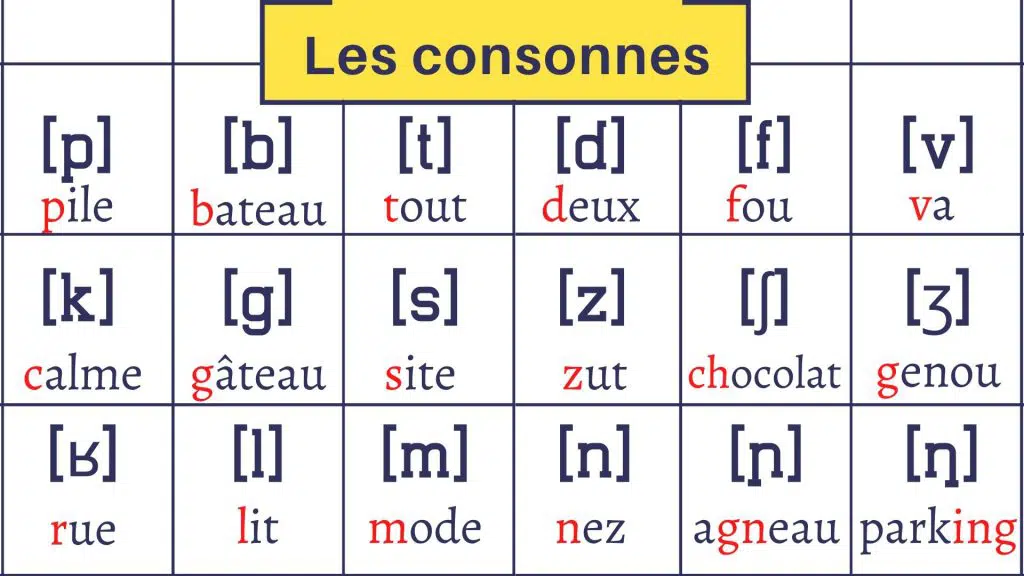
Listen to the sound of oral consonants in French. Click to listen to the French sound of /p/ /b/ /t/ /d/ /f/ /v/ /k/ /g/ /s/ /z/ /ʃ/ /ʒ/ /ʁ/ /l/.
How to pronounce the nasal consonants in French?
The nasal consonants in French are:
- /m/ as in the word maintenant
- /n/ as in the word non
- /ɲ/ as in the word magnifique
- /ŋ/ as in the word parking
Listen to the sound of nasal consonants in French. Click to listen to the French sound of /m/ /n/ /ɲ/ /ŋ/.
The air doesn’t go through your mouth; it should all leave through your nose.
- /m/: Close the lips and push air through the nose. No air should leave your mouth. Vibrate your vocal cords.
- /n/: Place the front of your tongue against the roof of your mouth, behind your teeth. The tip of your tongue should touch the roof of your mouth. Vibrate your vocal cords.
- /ɲ/: The central part of the tongue touches the hard palate, there is airflow through the nasal passages and then there is a sharp release of the tongue from the palate.
- /ŋ/: Lift the back of your tongue and place it against the soft palate at the back of your mouth. Vibrate your vocal cords. Do not let any air leave through your mouth; it should all leave through your nose.
Keep Learning with the French IPA
If you learn and practice with the French IPA, you will be able to pronounce any French word in the dictionary – even if you have never heard it before!
To learn about mandatory liaisons, what they are, and how to pronounce them in French read our article dedicated to Mandatory Liaisons in French.
This lesson on helping English speakers to start pronouncing French on their own is available on YouTube. For more videos, please be sure to subscribe to Master Your French YouTube channel.
Looking to learn French pronunciation? If so, get the online course to speak better French.
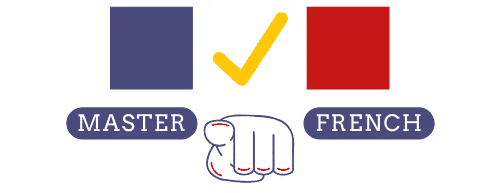


Hello,
I found this videos very helpful, but I have to say that as a person that is starting to learn French, the perfect pronunciation is crucial, nevertheless I felt a little bit frustrated because of the background music when she was pronouncing the sounds, it creates a little noise that made the listening more difficult.
Well, maybe that’s a good practice so I can really train my ear.
But, maybe for further videos, the volume of the background music should be less.
Thanks!
Hello Cristobal,
Thank you for your helpful comment. The pronunciation is indeed a very important factor when learning French. Regarding the video and the music, I took note of what you said in future videos.
Best regards,
Mylène
This is interesting, well done especially as we strive to speak like you native speakers
Bonjour ! Thank you for the comment. I’m glad that you find this article helpful. Mylène
Merci,
This article is helpful,
Looking forward to learn more from you.
Bonjour Janelle! Thank you for the comment! Mylène